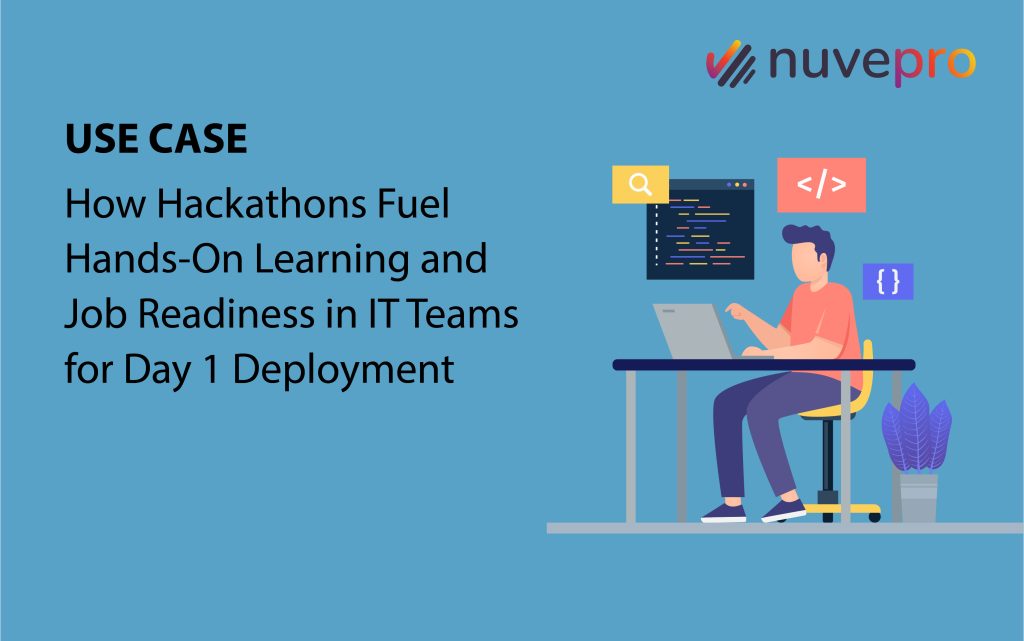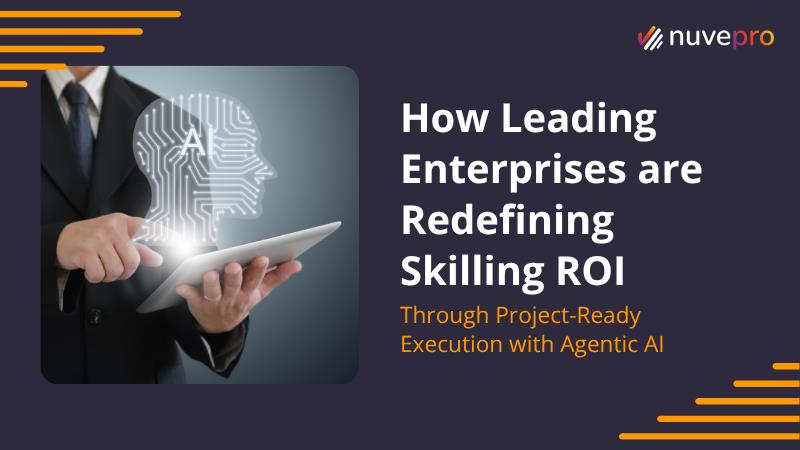In the fast-evolving world of technology, hiring and workforce training have become increasingly complex. With businesses depending on highly skilled teams to execute projects effectively, it’s no longer enough to rely on resumes, certifications, and interviews as a measure of an individuals’ potential. Instead, businesses are turning to more immersive methods like hackathons to better evaluate their workforce’s job readiness. Hackathons are proving to be a dynamic platform for engaging teams, promoting hands-on learning, and ensuring that new hires are truly job-ready from Day 1.
This blog delves into the challenges organizations face with traditional hiring and training methods, explains how hackathons provide a modern solution, and outlines the myriad benefits that hackathons offer for boosting a team’s job readiness and performance.
Challenges in Traditional Hiring and Training Processes
To understand how hackathons improve job readiness, it’s important to first examine the common challenges faced by organizations when relying on traditional hiring processes.
1. Resumes and Certifications Don’t Tell the Full Story
Despite their prevalence, resumes often paint an incomplete picture of an individual’s skills. According to a survey conducted by Glassdoor, 76% of hiring decision-makers believe that resumes fail to show an individual’s complete range of technical skills. While an individual may list qualifications and certifications, they often lack concrete evidence of how these skills are applied in real-world scenarios.
Certifications also have limitations. According to the Global Knowledge 2023 IT Skills and Salary Report, 65% of IT professionals say certifications help them validate their knowledge but don’t provide the hands-on learning experience that real-world problem-solving demands. Certifications reflect an individual’s theoretical knowledge but may not translate directly to practical proficiency, especially when it comes to handling complex technical challenges in a live project environment.
2. Interviews Focus on Individual Performance
Technical interviews often test an individual’s knowledge of data structures and algorithms (DSA) or isolated programming tasks. However, these tests tend to focus solely on individual performance and fail to capture how an employee works in teams. Research from LinkedIn shows that collaboration and teamwork are ranked among the top soft skills desired by employers in 2023, yet these traits are rarely measured during traditional hiring processes.
The reliance on employee-focused technical tests also neglects the group problem-solving skills critical for project execution. In today’s project-driven work environments, individuals must demonstrate their ability to work collaboratively, communicate effectively, and adapt to dynamic team environments. Interviews and coding tests simply don’t provide the opportunity to assess these vital skills.
3. Insufficient Assessment of Real-World Skills
While data structures, algorithms, and basic coding tests are important, they are not always reflective of the challenges encountered in day-to-day technical roles. For instance, many IT professionals work on cloud infrastructures, cybersecurity challenges, or DevOps automation. These roles require domain expertise that goes far beyond the foundational knowledge typically assessed during interviews.
According to a 2023 report by Burning Glass Technologies, nearly 70% of high-demand IT roles now require cloud-related skills, while 54% of cybersecurity job listings call for real-world experience. In such fields, employers need an employee who can demonstrate applied knowledge—something that theoretical tests and interviews are often insufficient to gauge.
4. Soft Skills Are Often Overlooked
Another major challenge in traditional hiring is the lack of attention given to soft skills. While technical skills are crucial for many IT roles, soft skills like communication, collaboration, and leadership are equally important for project success. The World Economic Forum’s Future of Jobs report predicts that by 2025, critical thinking, collaboration, and problem-solving will be among the top skills needed in most job roles.
Yet, these skills are rarely evaluated through traditional interviews or technical skill assessments. Without the ability to assess an employee’s teamwork and leadership capabilities, hiring managers risk bringing in employees who may not align well with the organization’s culture or work effectively within a team.
How Hackathons Address These Challenges
Hackathons have emerged as a solution to these traditional hiring challenges, offering a more immersive, hands-on learning approach to measuring both technical and soft skills. Here’s how Nuvepro’s hackathons can make a significant difference in preparing teams for success:
1. Hands-On Learning in Sandbox Environments
Nuvepro’s hackathons offer hands-on learning experiences within controlled sandbox environments, allowing participants to interact with real-world technologies and challenges. These sandbox environments simulate actual work conditions, ensuring that participants aren’t just tested on their theoretical knowledge but also on how they apply it. Hands-on learning has proven to be more effective than passive methods. A study by the National Training Laboratories found that participants retain 75% of the information they learn through hands-on practice, compared to just 5% from lectures. In the context of a hackathon, this type of learning is especially powerful, as participants must work under time constraints to solve complex problems—just like they would in a live project setting.
The hands-on labs and Nuvepro’s hands-on sandboxes are designed to cover a broad spectrum of technologies— including Cloud, DevOps, AI/ML, cybersecurity, and blockchain —giving teams exposure to the very tools they’ll be using in their day-to-day roles.
By providing employees with the opportunity to engage in real-world scenarios, employers can better evaluate how well they’ll handle future job challenges.
2. Measuring Both Hard and Soft Skills
Hackathons provide an excellent platform to assess both hard technical skills and critical soft skills like teamwork, leadership, and collaboration. Unlike traditional interviews, hackathons encourage participants to work in teams to solve complex problems. In fact, 90% of employers believe that soft skills like communication and teamwork are as important as technical skills for project success.
In group-based hackathons, participants are tasked with solving industry-relevant problem statements and working together to develop solutions. This allows hiring managers to observe how the new hires or employees communicate, collaborate, and lead under pressure. It also gives participants the chance to demonstrate their ability to adapt to different roles within a team, showcasing their job readiness for the multifaceted nature of real-world projects.
3. Exposure to Diverse Technologies
One of the standout benefits of Nuvepro’s hackathons is the breadth of technologies participants are exposed to. Unlike traditional technical tests that often focus on a single domain, hackathons allow employees to work on challenges spanning various fields, such as Cloud infrastructure, DevOps automation, AI/ML, and even emerging technologies like blockchain.
This cross-technology exposure is crucial, given that 91% of IT leaders report that their organizations struggle to find employees with expertise across multiple domains. Hackathons provide a practical solution to this problem by allowing participants to showcase their skills across diverse technologies, making it easier for employers to identify an employee who possess a well-rounded skill set.
4. Real-Time Tracking and Feedback
Nuvepro’s hackathons provide continuous tracking and auto-evaluation features that allow organizations to monitor participants’ progress in real time. The ability to track and map participants’ performance to desired job readiness skills offers a data-driven approach to hiring, ensuring that the right employee is selected based on quantifiable metrics.
In addition, the platform offers proctoring capabilities, which provide additional oversight to ensure that participants are fully engaged and adhering to the rules of the hackathon. This level of transparency is invaluable for organizations looking to make informed hiring decisions.
5. Benchmarking Future-Role Readiness
Hackathons offer organizations the opportunity to benchmark an employee against the requirements of specific job roles. By engaging participants in real-world challenges, hackathons provide insight into how well they’ll perform in technical projects after onboarding. This allows companies to place new hires in roles that best match their skills and strengths, improving Day 1 preparedness and overall job satisfaction.
A 2022 LinkedIn report revealed that employees who are well-matched to their roles are 12 times more likely to stay with the company beyond the first year. Hackathons help ensure that new hires are not only technically job-ready but also placed in roles where they can thrive and contribute meaningfully from the outset.
Benefits of Hackathons for Upskilling and Job Readiness
Hackathons are not only valuable for hiring but also serve as a dynamic tool for workforce skilling solutions. Here are some of the key benefits:
1. Cross-Technology Upskilling
The IT landscape is constantly evolving, with new technologies emerging regularly. Hackathons provide an excellent opportunity for existing employees to upskill in new areas. Whether it’s gaining proficiency in AI/ML or mastering Cloud DevOps practices, employees can use hackathons as a practical training ground.
According to Gartner, 58% of the workforce will need new skills to do their jobs successfully by 2025. Hackathons offer a way to continuously develop these new skills in a hands-on, engaging manner, helping employees stay relevant in an increasingly competitive job market.
2. Scalability for Global Teams
Nuvepro’s hackathons are highly scalable, accommodating anywhere from 50 to 50,000 participants without any major challenges. This scalability makes hackathons an ideal tool for large organizations with globally distributed teams. Hackathons can also be conducted remotely, allowing participants from different geographical regions to engage in the same challenges, breaking down barriers and fostering collaboration across borders.
In today’s increasingly remote workforce, the ability to scale workforce skilling solutions across multiple locations is crucial. A study by Upwork predicts that by 2028, 73% of teams will have remote employees. Hackathons offer a way to upskill and train these remote teams in real-time, ensuring they’re ready to tackle projects from any location.
3. Real-World Problem Solving
Nuvepro’s hackathons focus on solving industry-relevant problem statements, which ensures that participants are engaging with challenges they’re likely to encounter in real job roles. This real-world problem-solving approach is crucial for improving team readiness. A McKinsey report found that organizations adopting real-world simulations for training see a 46% increase in project success rates compared to those relying on theoretical learning methods .
By engaging in hackathons, employees are better prepared to face real-world project challenges, and organizations benefit from having teams that are ready to execute from Day 1.
Conclusion
Hackathons have become a vital tool for organizations aiming to bridge the skills gap and ensure new hires are job-ready from Day 1. These events offer an immersive, hands-on learning experience that effectively bridges the gap between theory and practice. By focusing on real-world problem-solving and skill assessment, hackathons help improve job readiness, project readiness, and overall team performance.
Incorporating hackathons into workforce training programs allows organizations to identify top talent and ensure their teams are equipped to thrive in today’s fast-paced, technology-driven environments. This dynamic and scalable approach not only evaluates and upskills employees but also boosts their engagement and confidence.
By making hackathons a core part of hiring and training processes, organizations can significantly enhance team job readiness and project success rates. This approach unlocks the full potential of teams, ensuring they have the skills, experience, and confidence to excel from the very start.




